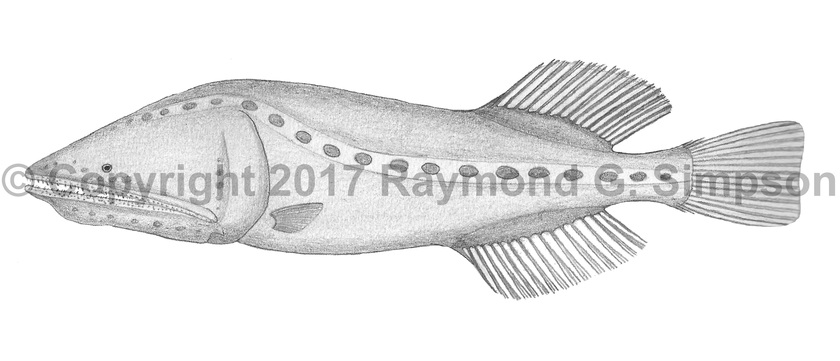
Common Name
Parr's Whalefish
Year Described
Bigelow, 1961
Identification
Dorsal Fin: 17
Anal Fin: 17
Pectoral Fin: 16
Lateral Line Pores: 14
Gill Arches: 3
Vertebrae:
Genus diagnosis after Paxton (1989) for females:
Dorsal fin base 24% SL. Head length 33% SL. Body rather elongated with a huge mouth (third of body length). Snout rounded. Head wider than body. Eye tiny. Nasal organ small. Jaws slightly convex to straight on upper but concave on lower. Three distinct gill arches. Gill tooth plates contiguous. Lateral line conspicuous with large round pores inside a channel with raised rim. Lateral pores lack small dermal flaps. No vertical rows of papillae on lateral line. Lateral line system continues onto head as a series of pores and sensory openings. Additional pores on lower jaw and snout. Jaw teeth relatively long (three times longer than wide) in irregular rows. Vomerine tooth patch rectangular or flat. Dorsal and anal fins located far back on body, with bases slightly elevated. Cavernous tissue located around the anus and anal fin base. None elsewhere on body Caudal fin with less than 17 principle rays. Pelvic fin absent. Pectoral fin small and inserted low on body. Body flabby and scaleless except for large, diagnostic scales associated with the lateral line canals.
Males and juveniles unknown.
Color
Preserved fish uniformly dark brown with darker finrays and lateral pores. Fresh material dark brown with blue eyes and lighter interior of mouth.
Size
Known material is 51mm SL.
Habitat
Type material bathypelagic around 2500m.
Range
Known from the Gulf of Mexico.
References
Bigelow, H.B. 1961. A new species of the cetomimid genus Gyrinomimus from the Gulf of Mexico. Breviora No. 145: 1-2.
Paxton, J.R. 1989. Synopsis of the whalefishes (family Cetomimidae) with descriptions of four new genera. Records of the Australian Museum v. 41: 135-206.
Other Notes
The taxonomy of the complex of species including Gyrinomimus myersi, G. simplex, and G. parri needs to be investigated further as there are few adult specimens, condition is poor, and variation is not understood in some of the characters used for identification. Gyrinomimus parri is kept separate for now due to it’s very long dorsal fin base which is much larger (24% SL) than Gyrinomimus myersi/simplex (<18% SL).